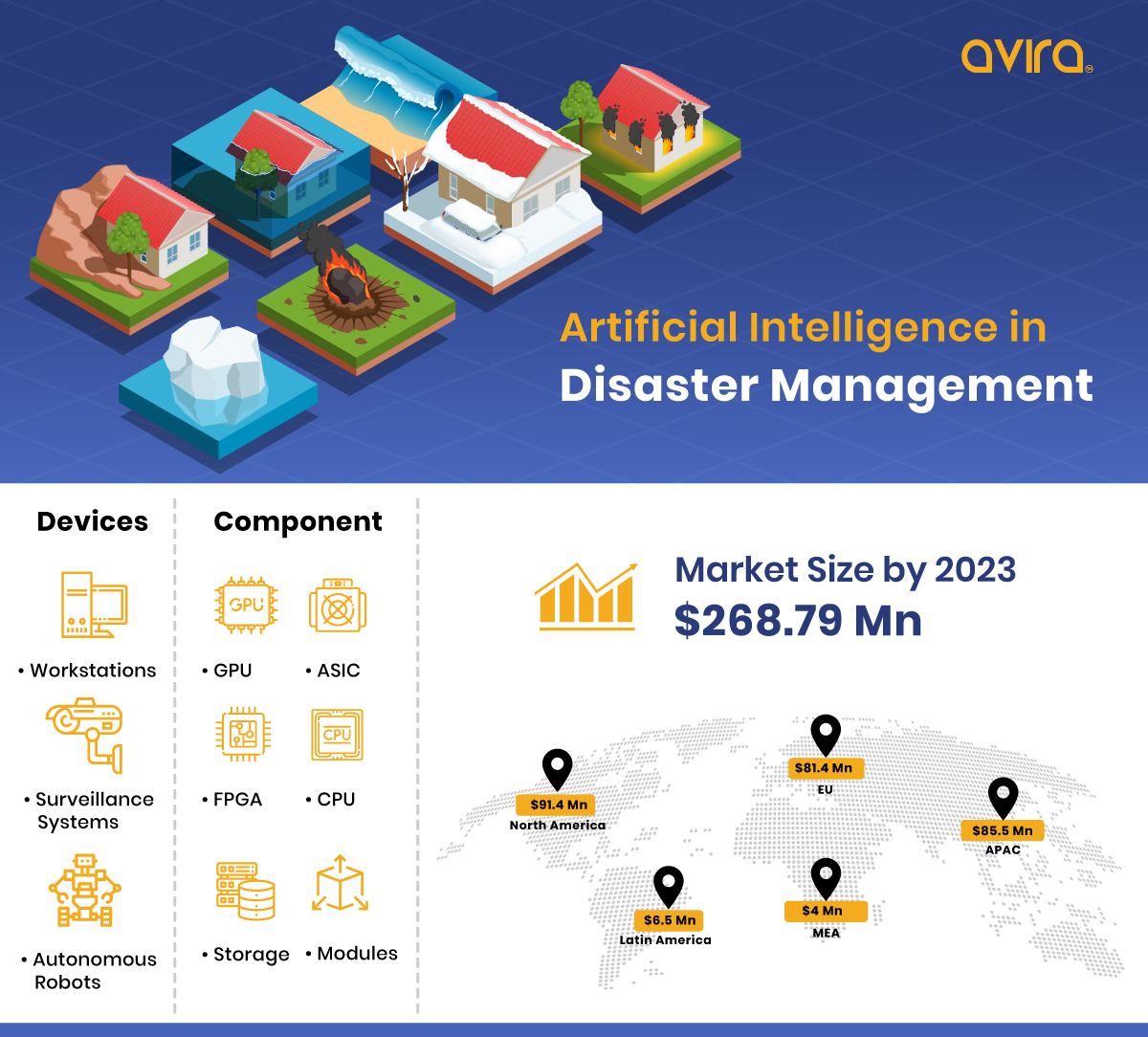AI Enabled Disaster Management Expected to Display Rapid Surge in Demand Due to Mass Adoption
AI enabled Disaster Management to cross $ 268.8 billion TAM by 2023. Natural disasters are on the rise due to rapid climate change. Artificial intelligence has stepped in to improve disaster response by way of reducing time to assess damage to monitoring social media activities to deliver aid more quickly and effectively. Governments are relief agencies are beginning to leverage the use of such technologies to co-ordinate better disaster relief programs. For instance, large scale movement and behaviour data that are run through predictive machine learning models can help officials send supplies to where people are going as compared to where they were.

More than 150 million people are affected by floods, hurricanes, and other natural disasters every year, and the situation is most likely to become more serious in the coming years. The occurrence of natural disasters has quadrupled since the 1970s, majorly due to global warming. Weather, geo-spatial and previous disaster data can be used to predict to track the movement of people during a natural disaster. These insights could allow disaster relief personnel to identify how much of the supplies such as water, medical care and food will be required and where. Machine learning algorithms are able to assess the quantum of flooding, road and building damage almost immediately, based on satellite feeds and weather forecasts, thus allowing the rescuers to distribute emergency supplies more effectively and also to identify people who are still isolated from escape routes.
Autonomous robots will play an imperative role in recovery operations that are far more dangerous for human rescue teams, such as earthquakes or nuclear disasters. The only drawback is that the current robots are limited by their abilities to interact with humans effectively. The Robot Project, funded by the EU has investigated challenges faced by robots during rescue operations, and has used the findings to develop an autonomous hybrid leg-wheeled robot. The speciality of this robot is that it can adapt itself to uncertain situations, through the parallel mechanism for movement.
In case of an environmental disaster, the first 72 hours is highly critical for the rescue operation teams. Responders depend on accurate geographic information to co-ordinate operations. Drones are highly preferred as they can be deployed immediately over disaster areas, and responders can use them through 3D maps, identify victims, and assess the severity of the damages done to the infrastructure. For instance, the anticipation of hurricane Florence’s landfall in 2018 has led Precision Hawk to partner with the North Carolina Department of Transportation (NCDOT) to launch a pre-emptive UAS response. The hurricane caused damages worth US$ 20 billion by disrupting power utilities, flooding etc. The NCDOT deployed more than 250 drones and captured close to 8,000 images and videos. Using visual confirmation, state agencies were able to deploy rescue teams effectively and divert people away from high risk areas.
Further, the Kilauea Volcanic Eruption in Hawaii, in May 2018, resulted in the obliteration of more than 700 homes in Leilani Estates, Hawaii. Emergency responders flew drones over the estate to inspect the houses for damage. They were able to conduct multiple ortho flights involving several DJI multi-copters to assess the quantum of the damage caused by the volcanic eruption.
The ecosystem of AI in Disaster Management has mainly 5 tiers.
• 1st tier which is of hardware is dominated by companies such as Analog Devices, Texas Instruments, ST Microelectronics, NVIDIA Corporation, Intel Corporation, Advanced Micro Devices Inc., Northrop Grumman, Lockheed Martin, DJI, and Thales among others
• 2nd tier which is software has the presence of companies such as SAP SE, IBM Corporation, Microsoft Corporation, and Google LLC among others,
• 3rd tier, which is SoC System Integrators, consists of companies like Trianz, Science Soft, etc.
• 4th tier is AI-enabled Disaster Management Platforms, and it has the presence of Microsoft Corporation, Google LLC, IBM Corporation, etc.
• 5th tier is CMS and ODMs which encompasses companies such as Foxconn, etc.
FABRIC has analysed AI enabled Disaster Management ecosystem and offer 7! cross segments. Avira’s market intelligence platform FABRIC has synchronized 235 high importance market activities using Machine Learning and Data Science Algorithms. We would love to exchange our methodology, datasets, and observations on the quick demo of FABRIC.
About AviraInsights Technologies:
AviraInsights is a market intelligence company. We have synergised our strengths of Information Technology, Consulting and Market Research to build our proprietary platform that helps our clients in effective decision making. Driven by a vision to be a one-stop business partner to all the growth and expansion plans of its clients, AviraInsights has built an alliance base to make the Intelligence-data not just academic, but actionable. Understanding business in its entirety on the back of the decades of experience of the Management team, the company strives to empower its clients by providing an Access to research, Analysis of key dynamics, Evaluation of market data, Application of it to business objectives.
Contact Us:
Rohan S
5890 stoneridge Dr, suite 216,
Pleasanton CA 94588
Phone
Email :
Website :